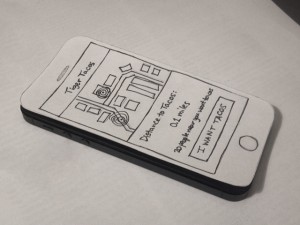
Observations
As someone who is five minutes late to everything, I thought it would be informative to arrive early to some of my classes and observe the foreign concept known as ‘waiting’. Professors Adam Finkelstein and Yael Niv offered interesting and unique examples of what can be done to improve the Princeton waiting time.
Adam Finkelstein, computer science
- shows an entertaining video before lecture as people are walking in
- people who are late don’t miss important material but early students aren’t bored
- gives a five minute break in the middle of class and ends five minutes early
- throws candy during class to people who ask or answer questions
Yael Niv, neuroscience
- in every class, she invites five students to coffee with her.
- ends class ten minutes early and takes those students to coffee before the next class
- reviews previous material at beginning of class
- frequent technical trouble with projector or mic could be addressed
Juan Albanell, sophomore
- says that ten minutes is the “perfect amount of time if teachers end class on time”
- suggestion: Make students ask questions at the beginning of class
Motivating Thoughts
“The constraints in a system are the rate-limiting step … and they ought to be the providers. In a private practice, things can only move as fast as the doctor-patient relationship.”
– Shortening Waiting Times: Six Principles for Improved Access, IHI.org
Though the above quote addresses the healthcare system and not education, there are some informative similarities and differences. The teacher-student relationship is still the rate-limiting step, but different constraints and liberties are placed upon the system. For one, classes are scheduled to begin and end at a certain time. Doctor’s appointments (except, say, psychiatrists) do not have this same endtime prescribed. Students struggle to arrive to class on time for a number of reasons, including the time at which the teacher of their previous class lets them out.
This establishes a sort of indirect relationship between teachers. If one professor’s lecture is running over, it causes students to be late to the next class, which causes that class to run over, and so on. Even if classes do not run over their allotted time slot, it is often the case that class is cut short of completion due to time limitations, and useful material is left uncovered or rolled over into the next lecture.
This is not to place blame on teachers for students’ being late—but it is an appropriate pain point to address. Like doctors, teachers are the “providers” of education, so changing the format of lectures could do more than changing students’ habits. In other words, students who are always late would not benefit long-term from any technology. Like the alarm clock, these technologies are quickly silenced and doomed to become stressful reminders rather than helpers. Teachers, on the other hand, can adopt simple changes and preparations that make better use of students’ time.
For example, if a teacher covers important logistical material at the beginning of class, some people will miss it and the material will eventually need to be repeated. It’s better to recap the last lecture or let students talk among themselves about the material while people come in. Maybe an optional self-quiz or group activity could be designed that encourages students to talk to people sitting around them.
At the same time, it’s important to address the quality of the teacher-student relationship, not just efficiency. Yael Niv’s solution is to end class systematically early and invite some students out to coffee every week. This means less time to go over lecture material, but more time spent with individual students. It also gives the rest of the students a larger break until their next class. Since the students she chooses are often ones that participate in class, it encourages students to come to lecture and speak up.
Brainstorm
In discussing the problem with other students and faculty, several types of solutions appeared. The first type of solution is to optimize the class selection process to reduce waiting and walking distance between classes. The second type addresses how teachers could work better within class time limits. The third is to improve the wait time vis-a-vis better teacher-student relations. The fourth is to provide new services that cater to students’ busy schedules.*
1. An upgraded scheduling system with travel time between classes to improve course selection and classroom assignment for both the registrar and students.
2. A modified presentation clicker that tells the teacher how many lecture slides they still have to go present, as well as how much time is left in class.
3. A heads up display on their laptop screen that performs the same role as above.
4. An app that allows teachers to push the remaining notes to students’ phones on the way out of lecture which they can view later in the day or while waiting for their next class.
5. A website called “Take a Teacher to Lunch” that helps students and teachers go to lunch before or after class.
6. A way for students to submit questions or discussion prompts to the teacher before class while they are waiting
7. A class-wide Wiki that students can update throughout the semester with their notes and comments. The entire class could collaborate to create a study guide or ‘course manual’ with help from instructors.
8. A study group app that helps you schedule times to meet with other people in your class and review material.
9. Just make the time between classes 15 minutes.
10. An app that tells you the closest dining hall to eat between classes.
11. An on-demand taco truck that will drive to meet students between classes at the location with the most requests made by phone during the last class.
Favorite Ideas
Ultimately, I decided to develop ideas #2 and #11. The improved presentation clicker is a simple idea with a tangible result, applicable in situations outside of just education. The crowdsourced taco truck, on the other hand, would integrate many different technologies at once and generate a lot of energy around campus—and provide an opportunity for classmates and teachers to grab a bite together after class.
Prototypes
I quickly designed a wireframe for a mobile app that would allow students to request the taco truck at their current location.
The design shows a map with the user’s location, the taco truck’s location, and a single large button. The truck would be instructed to head to the location on campus with the most requests at the moment.
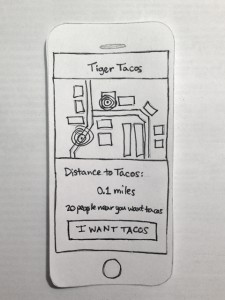
Below is the second design considered, a redesigned presentation clicker with a visual indicator showing how many slides are left in a presentation.
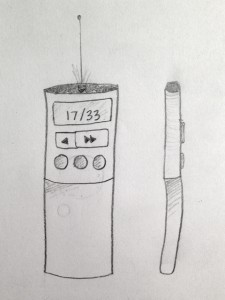
Testing
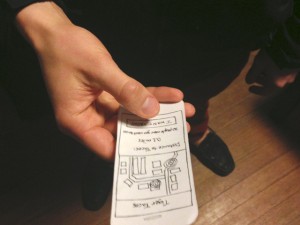
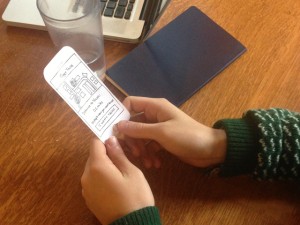
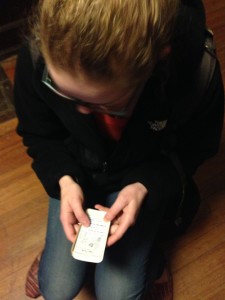 I brought the Tiger Tacos prototype to several students to get their feedback.
I brought the Tiger Tacos prototype to several students to get their feedback.
It was clear from testing that people “got” the idea, but several important assumptions were challenged nonetheless.
When I presented the prototype to Gavin Cook, he proceeded to enact a scenario in which he called a friend and invited them to get tacos after leaving class, only afterward pressing the “I want tacos” button in the app. The other testers were likewise wary of how they would have time to pick up tacos between classes if they had to wait for a truck to come.
This is informative: it means that the design did not convey how the app would work in reality—the user would likely have to send a request during class so that the taco truck has time to relocate. This could be better conveyed in future designs. Overall, though, feedback was positive and encouraging.
* Collaboration included discussion with Momchil Tomov, Shompa Choudhury, Nathan Eckstein, and Professor Zschau.

